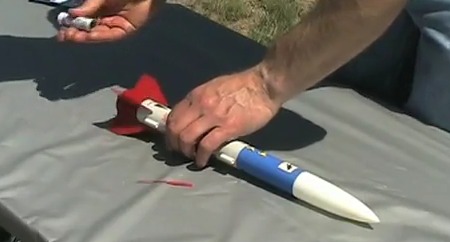Launch a model rocket
Build and safely launch a small model rocket using a kit, learn basic aerodynamics, countdown procedures, and safe outdoor setup and recovery.



Step-by-step guide to launch a model rocket
Easy-to-Use Model Rocket for Beginners
Step 1
Read the entire kit instruction manual and the safety section with an adult.
Step 2
Lay out every part on a clean surface and check them against the parts list in the manual.
Step 3
Assemble the rocket body following the kit instructions including attaching fins and the nose cone.
Step 4
Allow any glue or paint to dry for the recommended time in the manual.
Step 5
Fold the parachute neatly and pack recovery wadding into the rocket as shown in the manual.
Step 6
Install the correct model rocket engine into the engine mount according to the kit instructions.
Step 7
Insert the igniter into the engine and secure it exactly as the kit directs without connecting the launch controller.
Step 8
Put on your safety glasses.
Step 9
Set up the launch pad on flat open ground and make sure the launch rod is vertical and stable.
Step 10
Slide the rocket onto the launch rod and check that it slides freely without rubbing.
Step 11
Attach the launch controller clips to the igniter leads but leave the safety key out of the controller.
Step 12
With an adult check that wind is light the sky is clear and there are no nearby people buildings or power lines.
Step 13
Have everyone move back to the safe distance in the manual then the adult inserts the safety key and performs the loud countdown and presses the launch button to ignite.
Step 14
After the rocket lands walk with an adult to the landing area to recover the rocket and inspect it for any damage.
Step 15
Share a photo and a short description of your finished rocket and launch on DIY.org
Final steps
You're almost there! Complete all the steps, bring your creation to life, post it, and conquer the challenge!


Help!?
What can we use if we can't find the exact model rocket engines or igniters from the kit?
If the kit's specific model rocket engine or igniter is unavailable, buy the same certified engine impulse class and a matching certified model rocket igniter from a hobby shop and never substitute unapproved fireworks or homemade igniters.
My rocket keeps getting stuck on the launch rod or wobbles during lift-off — what should we check?
Follow the step 'Slide the rocket onto the launch rod and check that it slides freely' and if it sticks or wobbles, check fin alignment and centering, slightly sand or true the fin edges, ensure the launch rod is vertical and straight, and re-seat the engine mount before trying again.
How should we adapt this project for different ages?
For younger children have the adult read the manual, handle engine installation and igniter insertion while the child assembles fins, folds the parachute and practices safety steps; for older kids (8–12) let them do most assembly with adult supervision on the launch controller; and for teens let them manage full assembly, painting, the safety checklist and the postflight inspection and DIY.org post.
How can we make the launch more interesting or personalize the rocket?
After 'Allow any glue or paint to dry', personalize the rocket by adding custom paint or decals, decorate and pack the parachute neatly, install a small altimeter or lightweight nose‑cone camera, and document the flight with photos and notes for your DIY.org description.
Watch videos on how to launch a model rocket
Choosing Your First Model Rocket | A Beginner's Guide
Facts about model rocketry and aerodynamics for kids
⏱️ A loud countdown (like 5‑4‑3‑2‑1) helps everyone stay clear and coordinated for a safer launch.
🚀 Model rockets can fly from a few hundred feet up to several thousand feet depending on the engine and rocket size.
🪂 Most model rockets use parachutes or streamers to slow descent so the rocket can be safely recovered and reused.
🔥 Rocket motors are solid fuel for model rockets and are classified by letters (A, B, C...) where each letter roughly doubles the total impulse.
🧭 The National Association of Rocketry publishes safety codes that recommend open launch areas, clear recovery zones, and wind limits.
How do you build and safely launch a model rocket?
What materials do I need to launch a model rocket?
What ages is model rocketry suitable for?
What are the key safety tips for launching model rockets?


One subscription, many ways to play and learn.
Only $6.99 after trial. No credit card required


